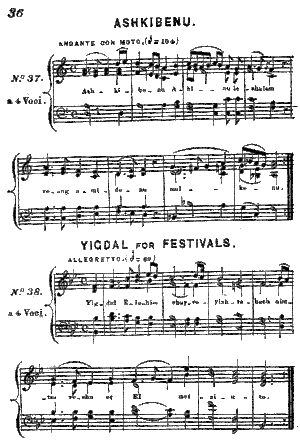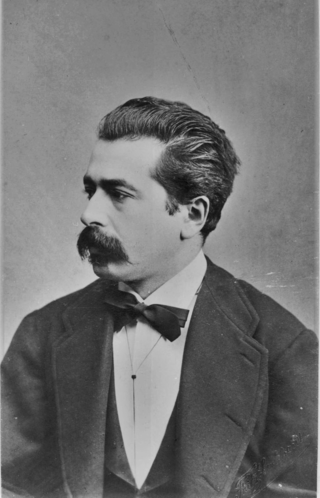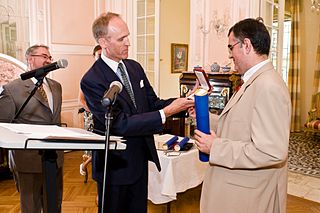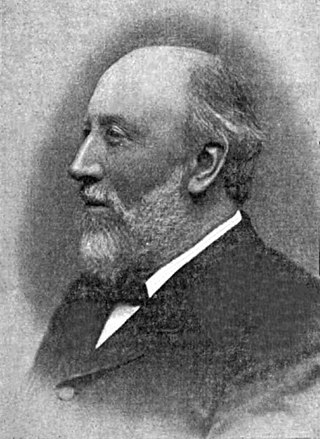
Emanuel Abraham Aguilar (23 August 1824 – 18 February 1904), was an English concert pianist and composer of Portuguese parentage. [1]

Emanuel Abraham Aguilar (23 August 1824 – 18 February 1904), was an English concert pianist and composer of Portuguese parentage. [1]
Born in Clapham, London, Aguilar was the son of Sephardic Jewish refugees from Portugal who settled in London. His father was the city merchant Emanuel Aguilar (1787–1845) and his mother Sarah Diaz Fernandez (1787–1854). His sister was the novelist Grace Aguilar. He studied piano and composition in Frankfurt, and was the first to perform Chopin’s F minor Concerto there. [2] In 1847 his sister, whose health was already failing her, visited him at his Frankfurt home and died there, aged 31. [3]
Returning to London in 1848 he established himself as a soloist and set himself up as a teacher - though he frequently returned to Germany for concerts (for instance at the Gewandhaus in Leipzig on 30 March 1848) and as a visiting composer, as for the premiere performance of his second symphony in 1851. [4]
From the 1850s Aguiar lived at 68 Upper Norton Street (now Bolsover Street) in Marylebone. Later addresses were 17 Gloucester Crescent in Paddington (from the 1870s), and at the lodging house 7 Weymouth Street in Marylebone (1901–1904). He married twice and was widowed twice. His first wife was Sarah Lindo, who he met in Frankfurt and married there in 1848. She died on giving birth to their fifth child in 1868. His second wife was Ellen Britton, who died in 1883, aged 42. [5] Aguilar died in Marylebone, aged 79. [6]
His official opus 1, the Grand Duo Concertant for cello and piano, was published in Leipzig in 1848. [7] Three symphonies form the core of his orchestral work and show the extent of his early ambitions as a composer. Symphony No 1 in C was a student work, composed in 1844 and premiered in Frankfurt. The Symphony No 2 in E minor received its orchestral premiere in 1851, also in Frankfurt. The Symphony No 3 was composed in 1854 and received a London premiere. [4]
There were two operas: The Wave King (1855, based on a romantic German legend) and The Bridal Wreath (1863). Both remained unstaged, although a concert performance of The Wave King was heard in a private performance at 148 Westbourne Terrace in April 1863, [8] and parts of The Bridal Wreath were given at the tenor Trelawney Cobham's concert at the Vestry Hall in Chelsea on Monday 11 March, 1867. [9] And there were three cantatas: Summer Night (1875, text by Camilla Dufour Crosland); [10] The Bridal of Triermain (Walter Scott, produced at a Bedford Musical Society concert, 27 October 1880); [11] and Goblin Market (1880, adapted in collaboration with the poet Christina Rossetti). [2] The latter, lightly sanitised to make it acceptable for school children (it is marked "for treble voices"), received "a modest performance" at the composer's home on 10 January 1880. [12]
Later in his career there were many songs, piano solos (including the Sonata in C, 1865 and the four Morceaux de Salon, 1869), piano duets, [13] and a substantial amount of chamber music, including three trios, two quartets, a piano quartet, a sextet and a septet. Many of these were performed at Musical Artists' Society concerts. [4] He also published a collection of canons and fugue transcriptions intended as preparatory exercises for the playing of Bach, as well as A Little Book About Learning the Pianoforte (1866, revised and expanded as How to Learn the Pianoforte, 1883). [1] [14]
However, Aguilar's most enduring work, still in use today, was his religious music for the Spanish and Portuguese Jews’ Congregation of London. He is remembered for notating and arranging The ancient melodies of the liturgy of the Spanish and Portuguese Jews, published in 1857 in collaboration with the rabbi and author David de Aaron de Sola and the Spanish-Portuguese synagogue of Bevis Marks in London. [15]

Joseph Joachim Raff was a German-Swiss composer, pedagogue and pianist.

Niels Wilhelm Gade was a Danish composer, conductor, violinist, organist and teacher. Together with Johan Peter Emilius Hartmann, he was the leading Danish musician of his day, in the period known as the Danish Golden Age.

Henryk Wieniawski was a Polish virtuoso violinist, composer and pedagogue, who is regarded amongst the most distinguished violinists in history. His younger brother Józef Wieniawski and nephew Adam Tadeusz Wieniawski were also accomplished musicians, as was his daughter Régine, who became a naturalised British subject upon marrying into the peerage and wrote music under the name Poldowski.

Tobias Augustus Matthay was an English pianist, teacher, and composer.

Alfredo Casella was an Italian composer, pianist and conductor.

Sir Arthur Somervell was an English composer and educationalist. After Hubert Parry, he was one of the most successful and influential writers of art song in the English music renaissance of the 1890s–1900s. According to Michael Hurd, his most important work is found in the five song cycles, particularly his settings of Tennyson in Maud (1898) and Housman in A Shropshire Lad (1904).

Ignaz Brüll was a Moravian-born pianist and composer who lived and worked in Vienna.

Salomon Jadassohn was a German pianist, composer, and teacher at the Leipzig Conservatory.

Sir Julius Benedict was a German-born composer and conductor, resident in England for most of his career.

Sir Frederic Hymen Cowen, was an English composer, conductor and pianist.

Sir George Alexander Macfarren was an English composer and musicologist.

Emánuel Moór was a Hungarian composer, pianist, and inventor of musical instruments.

Șerban Nichifor is a Romanian composer, cellist and music educator.

Charles Kensington Salaman was a British Jewish composer, pianist, and writer. He was the composer of more than one hundred settings of Hebrew texts for the West London Synagogue, as well as numerous songs in English, French, German, Italian, Spanish, Latin, and Greek.

John Francis Barnett was an English composer, pianist and teacher.

Wilhelm Kuhe was a Czech pianist and piano teacher, composer and administrator born in the city of Prague, in the first half of the nineteenth century.

Johann Baptist Krall was an Austrian composer, conductor, music editor/arranger, and member of the board of directors of the Wiener Singverein of the Gesellschaft der Musikfreunde.

Walter Cecil Macfarren was an English pianist, composer and conductor, and a teacher at the Royal Academy of Music. His students included Stewart Macpherson, Tobias Matthay and Henry Wood.
Oliver Arthur King was a British composer, pianist, organist and conductor.
Frederick Laurence was a British composer, early film music pioneer and latterly an orchestral manager and administrator. He changed his name mid-career by deed poll in 1919 to avoid the anti-German sentiment prevalent in Britain at the time.